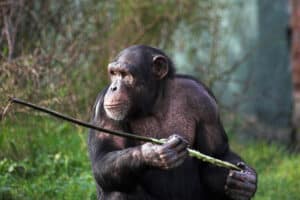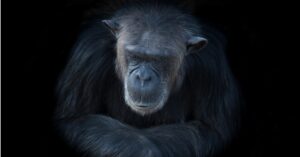Man’s closest relative is the chimpanzee, with around 99% of the DNA shared between our two species. Looking at the chimp, we get a view of how similar our two species are.
Chimpanzees belong to the order of Primates, which is estimated to have more than 375 members. 4 great apes exist, counting chimpanzees. Gorillas, orangutans, and humans are also members of the Great ape or Hominidae family.
Chimpanzees are unique creatures, and their lifestyle has some resemblance to our own. Black hair covers their body, and they have a humanoid structure. One of the few animals with opposable thumbs, and human-like features, the strength is much stronger than our own. The average chimpanzee is extremely strong and 1.5 stronger than a human on average.
Most chimps are not as large as humans on average, but some have been reported to be as large as small gorillas – most notably, the Bili ape. How big can chimpanzees get?
What is a Bili ape’s size?
Let’s dig into reports of the Bili ape, which is reported to be the largest chimpanzee ever and is often called the lion killer chimp!
How Big Do Chimpanzees Get
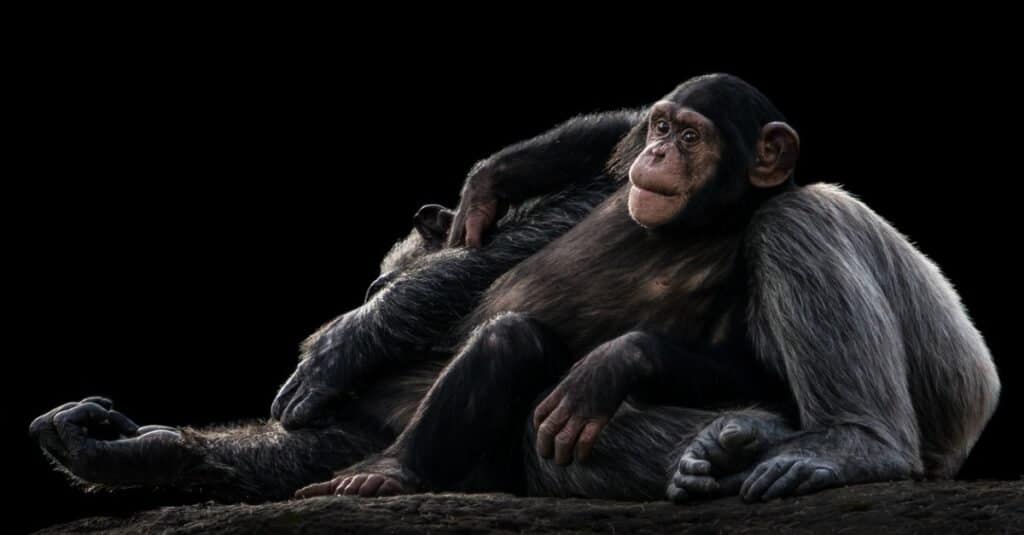
Chimpanzee males can reach 176 pounds on the upper end of their average weight range.
©iStock.com/abzerit
When standing upright, chimps measure around 3.3 to 5.6 feet tall (1 to 1.7m). Most of the time, chimps will walk on all fours because they have long arms and short legs. Male chimps are larger and stronger than females. The hierarchy of chimps usually puts the larger male at the top. At 6 feet tall, a male Bili ape would reign supreme!
Males weigh between 74 and 154 lbs (34 to 70kg), while females weigh 57.3 to 110 lbs (26 to 50kg). In captivity, chimpanzees can be much larger since they eat more and are less active. Males in captivity reach up to 176 lbs (80kg) and females 149 lbs (68kg).
Are “Lion Killer” Bili Apes the Largest Chimpanzees in the World?
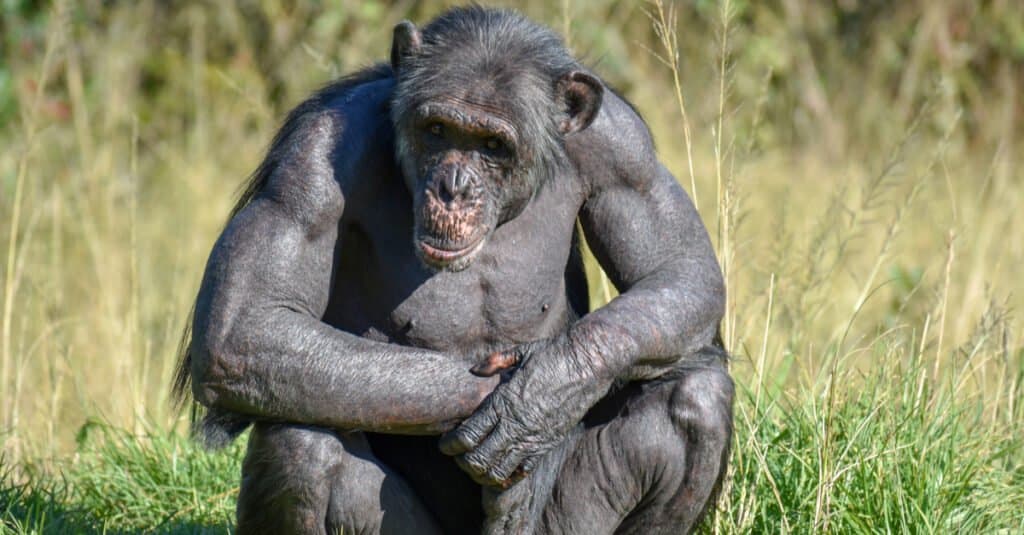
Alpha-male chimpanzees can be extremely strong.
©Darren Hopping-Mills/Shutterstock.com
Many sources will claim that the Bili ape is the largest chimpanzee, but this is a disputed claim. Let’s dive a bit more into why the “lion killer” Bili apes have been the source of so much controversy.
Reports out of the deep Congolese jungle have stated larger chimpanzees (with gorilla-like qualities) lived deep in jungles near the border of the Democratic Republic of Congo and the Central African Republic. The chimpanzees from the area became known as “Bili apes.”
Tribal sources claimed Bili apes also howled at the moon, nested like gorillas, would feast on predators like leopards (and perhaps even lions), and could grow to sizes beyond other chimpanzees. At their reported height of up to 6 feet tall, Bili apes would be the largest chimpanzees in the world.
Interest in Bili apes led to several expeditions to monitor them. Cleve Hicks, a primatologist who led several expeditions into the jungle, found that Bili apes are not a unique chimpanzee subspecies and that many of the claims around their behavior (such as howling at the moon) are exaggerated.
However, there are unique aspects to the chimpanzee populations in the area which may stem from their remoteness from human populations. DNA testing shows that Bili apes are the same subspecies as other apes in Central Africa, so it’s unlikely they reach a dramatically larger size than other chimpanzees. Yetr, there is still much to be learned about these remote apes!
Chimpanzees Compared With Other Apes
Gorillas, chimpanzees, humans, and orangutans are all members of the Hominidae family. The largest of great apes is the gorilla, and the bonobo, which is closely related to the chimpanzee, is the smallest. Each genus of great apes aside from humans has different species and subspecies within it. Gorillas and chimpanzees both live in Africa, while Orangutans live in the Southeast Asian islands of Borneo and Sumatra.
Gorillas are the strongest and largest of all primates. The size of the gorilla depends on the species, and the eastern lowland gorilla is the largest. Chimpanzees are smaller than humans but are stronger and more muscular. All primates are omnivores, however, their diets tilt mostly toward plants.
For example, chimpanzees eat 90% plant matter. Just 6% of their diet comes from animal products while 4% is from insects. Gorillas eat even more plants, occasionally feasting on termites to augment their diet.
Compared to chimps, orangutans are larger and much stronger. Chimps are more violent and are one of the most dangerous species of the great ape. In the wild, some chimps are known to have wars and attack each other for territory.
On rare occasions, chimps were seen attacking gorillas for no reason. It is believed that the loss of habitats for both species has caused chimps to become more territorial.
Where Do Chimpanzees Live?
Chimpanzees are one of the closest living relatives to humans and are found in the wild across a number of African countries. They are primarily located in the rainforests and savannas of central and West Africa.
In the wild, chimpanzees can be found in countries such as the Democratic Republic of the Congo, the Central African Republic, Cameroon, Nigeria, Senegal, Tanzania, and Uganda. They are known to inhabit a variety of habitats, including tropical forests, savannas, and mountainous regions.
One of the largest populations of wild chimpanzees is found in the Taï National Park in Côte d’Ivoire. This park is considered to be one of the most important sites for the conservation of chimpanzees, as it is home to a large and diverse population of primates.
Chimpanzees are also found in a number of protected areas and national parks, where they are protected from habitat destruction and hunting. Some of these protected areas include the Gombe Stream National Park in Tanzania, the Mahale Mountains National Park in Tanzania, and the Kibale National Park in Uganda.
The Hierarchy of Chimps

Chimpanzees will go to “war” to defend their territory.
©Afandi Teguh Afriyanto/Shutterstock.com
In the chimp hierarchy, the strongest chimps help lead the group. Male chimps who run the pack are called alphas and are at the top.
The alpha is above other males and gets to that spot through strength or kindness. Chimps who are stronger can try to intimidate their way into an alpha position, but creating bonds and doing favors for other chimps is also a way to gain status.
Chimps’ hierarchies are essential in maintaining a group’s survival. Alpha chimps have the job of patrolling and breeding with prime females. Strong chimps are preferred as the alpha, as others are always trying to fight their way to the top.
Chimps’ social groups mirror how humans interact with the world. Different groups of chimps will go to war with each other for territory and mating rights. War is one of the reasons that stronger and larger chimps are preferred for the alpha spot and gain breeding rights.
Alpha females also exist and have rights to food and breeding. Alpha females gain status through social interactions and have a high chance of bearing high-status offspring.
The Decline Of Chimpanzees
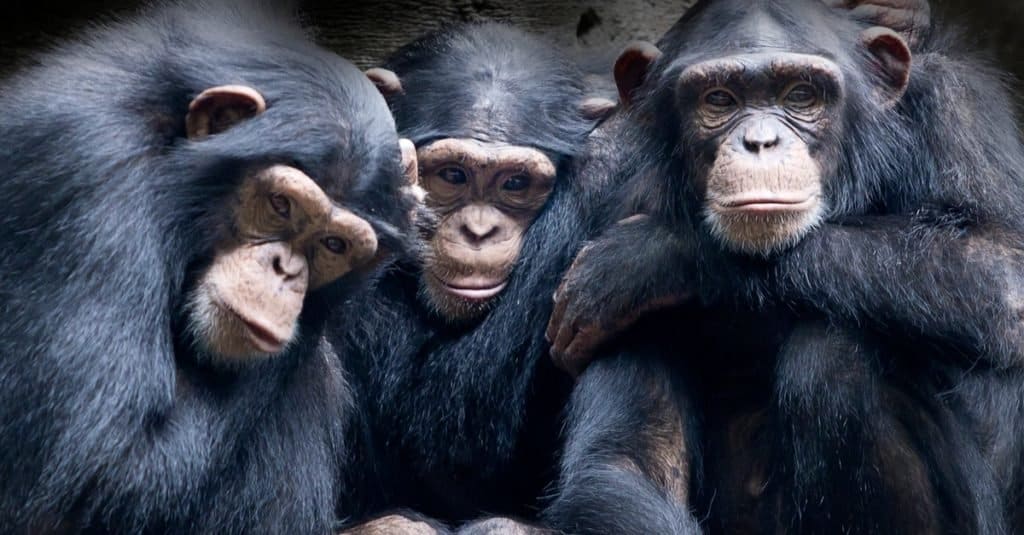
Humans and chimpanzees share 95 to 98 percent of the same DNA.
©Lili Aini/Shutterstock.com
Habitat loss, disease, and poaching are some reasons that have caused chimps to become endangered. They also have a reproduction rate similar to humans and have an 8-month-long gestation period. Chimps also are more prompt to go to war for territory due to increased habitat loss.
Around 170,000 to 300,000 chimps remain in the wild, and after three decades, they may become extinct. Laws and establishments have been put in place to project chimp populations and the habitats they live in. Limiting the tourists in areas and further studying chimps is helpful in trying to preserve what little number the left.
They are one of the closest species to depict our evolutionary past, and the future of chimps is in our hands.
The Largest Extinct Ape
Gigantopithecus blacki is the largest ape ever to exist. It is now an extinct species and lived in China, India, and Vietnam around 300,000 to 1 million years ago. This giant stood 9.8 feet (3m) and weighed around 1100 lbs (500kg). Like the gorillas of today, this species was mostly a herbivore.
Climate change was why this species went extinct, as its size became a hindrance. Many great apes today are endangered, and preserving their species can help prevent them from ending up like this ancient giant.
Bili Ape Behavior
According to many animal experts, apes tend to behave more like gorillas than chimpanzees. For example, they like to build ground nests as gorillas do. They will use interwoven branches and saplings and bend them forward or down into a central bowl.
They like nests in trees as well. Often times ground nests are found beneath or around tree nests. The diet of Bili apes consists of fruits or fruit trees such as figs are often consumed.
When confronted with humans, they not only will approach people but will show a general interest in them. They may come face to face with you and stare intently and then move away. There is usually no fear or aggression like in many other primates. For example, the gorilla male will always charge at a human when encountering one.
Although if found in the wild, it is always best to remove yourself from the situation and leave the animal alone. These mammals have also been known to flee from encounters with humans.
Are humans 99% chimpanzee?
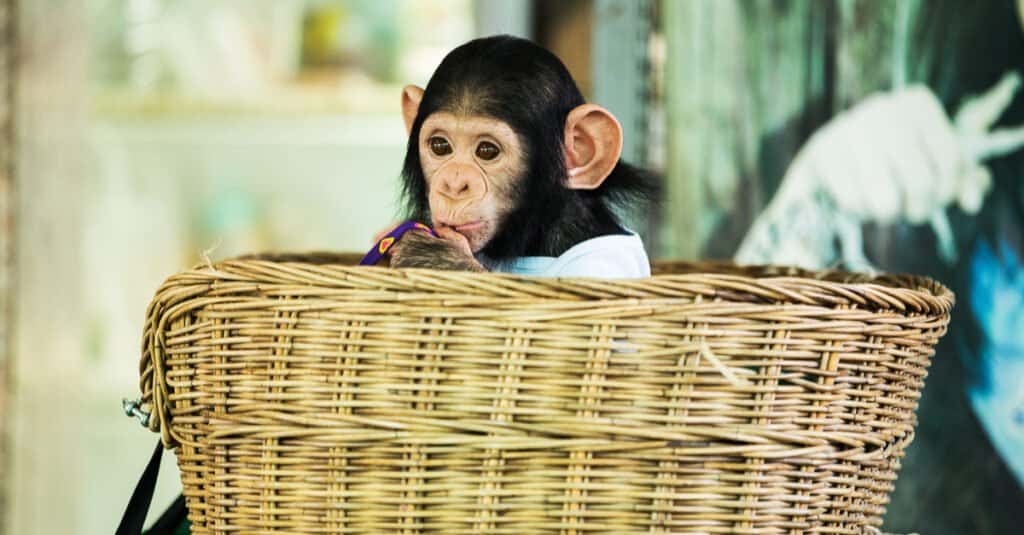
Chimps and humans share 98.8% of their DNA structures.
©subin pumsom/Shutterstock.com
As much as we might want to deny or sidestep our evolutionary connection to these apes, chimpanzees do share about ninety-nine percent of our human DNA.
If DNA is the molecule that gives our bodies the boilerplate to build our structures, why are the two DNAs so similar to each other? Scientists believe that the reason for this similarity is that chimps and humans are descendants of the same ancestor that dates back to roughly seven million years ago. Through the passing of those millions of years, the differences were pasted along and the differences grew and grew.
So to answer the original question if humans are 99 percent chimpanzee, no they are not. Not exactly. Having very similar DNA is not quite the same thing, but it does give clues to understanding how each developed over time.
The photo featured at the top of this post is © Darren Hopping-Mills/Shutterstock.com
Thank you for reading! Have some feedback for us? Contact the AZ Animals editorial team.





